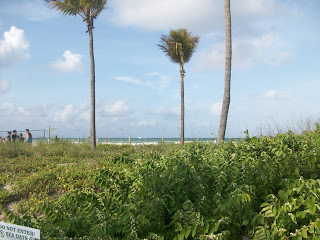Post No. 36 Seat Oats. A tall grass (Uniola paniculate) that has
panicles resembling those of the oat, grows chiefly on the coast of the
southern U.S. and is useful as a sand binder (Merriam Webster Dictionary).
Sea oats is a long lived, slow growing, warm season, perennial grass commonly associated with the upper dunes along beach fronts. It grows erect to approximately 6 feet in height at maturity and has leaves that can grow to 24 inches in length. The leaves are narrow, less than 1 inch in width, and taper towards their ends. Seat oats is very drought tolerant. This species produces a massive root system and will tolerate salt spray and brief inundation with salt water. It prefers full sun, and thrives in areas with blowing sand, such as dunes along the upper beach front.
Sea oats is an extremely valuable plant for coast line and barrier island protect. Its massive root system is capable of holding soil and sand in place during extreme weather events such as hurricanes and tropical storms. This plant’s habitat puts it at the forefront of shoreline protection. It is also capable of catching blowing sand and building dunes. It is very important to natural and artificial dune stabilization throughout much of its range. (USDA NRCS)
Florida Statutes prohibit removal of Sea Oats:
Chapter 161.242 Harvesting of sea oat and sea grapes prohibited; possession
prima facie evidence of violation.
(1)
The purpose of this section is to protect the beaches and shores
of the state from erosion by preserving natural vegetative cover to bind the
sand
(2)
It is unlawful for any purpose to cut, harvest, remove, or
eradicate any of the grass commonly known as sea oats or Uniola paniculate and
Cocolobis uvifera commonly known as sea grapes from any public land or from any
private land without consent of the owner of such land or person having lawful possession
thereof. Possession of either Uniola paniculate or Coccolobis uvifera by other
than the owner of such land shall constitute prima facie evidence of violation
of this section. (Former 370.041)
References:
Sea Oats. Time:
4:23:
How to Plant a Sea Oat. Time: 12:35:
Dancing Sea Oats. Time: 2:47:




Comments
Post a Comment